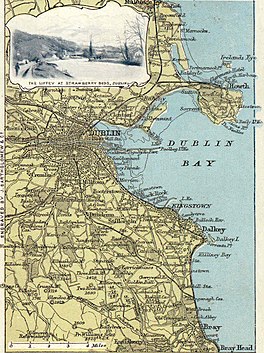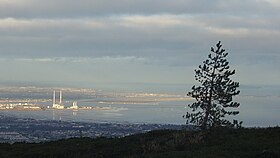| Dublin Bay | |
|---|---|
 Map from late 19th-century postcard | |
| Coordinates | 53°20′N 6°07′W / 53.333°N 6.117°W |
| Part of | Irish Sea |
| Primary inflows | |
| Settlements | Dublin, Dún Laoghaire |

Dublin Bay (Irish: Cuan Bhaile Átha Cliath) is a C-shaped inlet of the Irish Sea on the east coast of Ireland. The bay is about 10 kilometres wide along its north–south base, and 7 km in length to its apex at the centre of the city of Dublin; stretching from Howth Head in the north to Dalkey Point in the south. North Bull Island is situated in the northwest part of the bay, where one of two major inshore sand banks lay, and features a 5 km long sandy beach, Dollymount Strand, fronting an internationally recognised wildfowl reserve. Many of the rivers of Dublin reach the Irish Sea at Dublin Bay: the River Liffey, with the River Dodder flow received less than 1 km inland, River Tolka, and various smaller rivers and streams.

The metropolitan area of the city of Dublin surrounds three sides of the bay (the north, west, and south), while the Irish Sea lies to the east. Dublin was founded by the Vikings at the point where they were able to ford the River Liffey with the first wattle bridge up from the estuary. The city spread from its birthplace, around what is now the James's Gate area, out along the coastline, northeast towards Howth and southeast towards Dalkey.
UNESCO has designated Dublin Bay a 'biosphere reserve' in recognition of its unique ecological habitat and biological diversity;[1] the bay is also covered by multiple other official and protective designations.
- ^ Sorcha Pollak (24 June 2015). "Dublin Bay awarded biosphere designation by UNESCO". The Irish Times. Archived from the original on 11 May 2017. Retrieved 25 April 2017.
